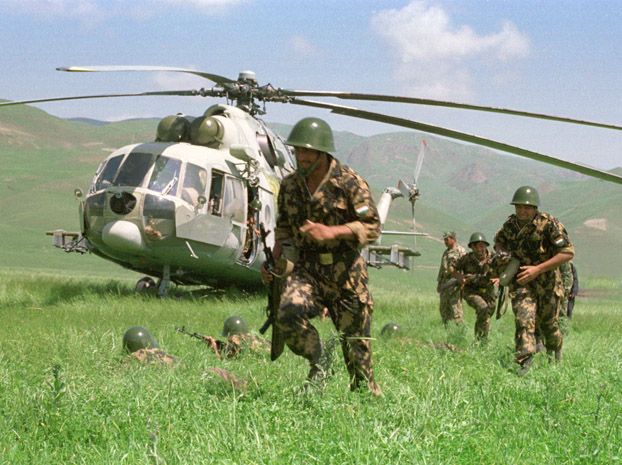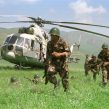
Transformation of Russian Combat Training Begins
Publication: Eurasia Daily Monitor Volume: 6 Issue: 110
By:

On June 3 the Collective Security Treaty Organization (CSTO) defense ministers met to consider intensifying military cooperation and formalizing the new rapid reaction forces. They are currently finalizing preparations to hold a CSTO military exercise in Belarus to "test" the new formation. Leanid Maltsaw, the Belarusian defense minister said the numbers earmarked for the exercise have yet to be agreed. However, the decision to host the exercises in Belarus circumvents the issues raised by the Belarusian constitution, which prohibits the deployment of its armed forces beyond its borders, and thus allows the new paper force to at least appear credible (ITAR-TASS, Zvezda TV, June 3).
CIS defense ministers also discussed conceptualizing military cooperation plans for the period 2010-15, improving the unified air defense system, forming a single military information system, flight security, radio-electronic compatibility, an identification of friend or foe system, as well as cooperation of engineering corps and topographic services and the joint air defense exercise, "Combat Commonwealth 2009." Aleksandr Sinayskiy, the secretary of the council of defense ministers said that an "air-space defense and air defense drill in Ashuluk (training ground in Astrakhan Region) in Russia, and in Kazakhstan, is planned for August-September," which he suggested was primarily a counter-terrorist exercise (Rossiya TV, June 3). It appears that some of the lessons learned by the Russian military following an analysis of its war in Georgia in August 2008 are being incorporated into military cooperation plans.
Russia’s CIS neighbors and its allies in the CSTO are being affected by the overhaul of the Russian military’s training structures. Combat training within the Russian armed forces is currently undergoing a significant level of transformation. The number of training ranges will be reduced by two thirds by 2010. On June 2 the Russian first deputy defense minister Colonel-General Aleksandr Kolmakov announced the planned "optimization," which will affect the army and navy with the number of ranges reduced from the present level of 296 to 108. It is also planned from 2010 to conduct combat training for the ground forces on 13 training ranges: eleven of them within the military districts (MD’s), one in the airborne forces, and another in the Kaliningrad special region. Inter-service training will be carried out within regional centers, district facilities, aviation training centers and complexes for mixed-force groupings, while training for mountain warfare will be held at the Daryal base in the North Caucasus MD (www.gazeta.ru, May 19).
Moreover, General Kolmakov revealed the results of combat training over the past winter period (December to May). He confirmed that training has been adjusted based on the experience of the war with Georgia and that military exercises are being modified in response to the recent controversial NATO exercises held in Georgia. He designated as "good" the training performance of more than 30 percent of the force groupings, 54 percent of divisions, 48 percent of equipment storage facilities, 28 per cent of brigades, 47 per cent of regiments, and 52 per cent of "first-rate ships." However, he said that four force groupings were rated as "poor" and these were mostly naval elements. Despite these figures Kolmakov claimed that military reform remains on track, and that some of these performances reflected the higher demands being placed on the military units. Four brigade, 14 battalion, and 184 company exercises and 3,700 live-firing drills of subunits occurred in the period. The largest involved a special "study exercise" focussing on the 74th Brigade of the Siberian MD, which revealed a lack of tactical independence of battalions and brigades in all types of combat (Vremya Novostei, May 21).
Kolmakov’s emphasized some positive aspects including an apparent 10 percent increase in the number of pilots and 16 percent more navigators trained in the air force compared with 2008. He boasted that the navy had put to sea its ships and submarines on 488 occasions in the winter period. "There was an increase in the time that these vessels spent at sea," Kolmakov asserted, while also admitting the growth was "negligible." (Vremya Novostei, May 21).
Commenting on plans for the summer training period, Kolmakov highlighted "West 2009," "Ladoga 2009" scheduled for September and "Kavkaz 2009" in June. He ascribed particular significance to the latter, stating that the exercise in the North Caucasus has been adjusted based on an examination of the NATO exercises in Georgia. According to Kolmakov, "practically all the brigades of the North Caucasus MD will participate," enlisting manpower and equipment from other MD’s and promising that "Kavkaz 2009" will be "reasonably large, comparable with those that were staged in Soviet times" (Vremya Novostei, May 21).
He said that despite claims made by the Chief of the General Staff Army-General Nikolai Makarov, the size of the new Russian bases in Abkhazia and South Ossetia might be smaller than first planned. Makarov had stated that each would involve 3,700 personnel, while Kolmakov explained that owing to problems related to the rotation of these forces they will each contain only 1,700 troops. Owing to the operational experience and failings encountered during the Russian military campaign in Georgia last year, he noted that improved communications and intelligence gathering assets will be provided at tactical command level. Moreover, military manuals adopted only 18 months ago will now be revised, while combat training manuals will also be reworked -previously updated only every 10-12 years. General Makarov said on June 5 that new combat training programs and manuals will be introduced to the "new look" Russian military by January 1, 2011 (Vremya Novostei, May 21, Interfax, June 5).
In the statistics provided by Kolmakov, which must be treated cautiously, he provided evidence that the reform program is having a marked impact on combat training -both structurally and in rapidly revising its conceptual approaches. The massive changes underway within the Russian armed forces are beginning to influence planning for joint and multilateral exercises. As the reform agenda is implemented, changes to combat training might provide a crucial barometer for measuring its overall success.




